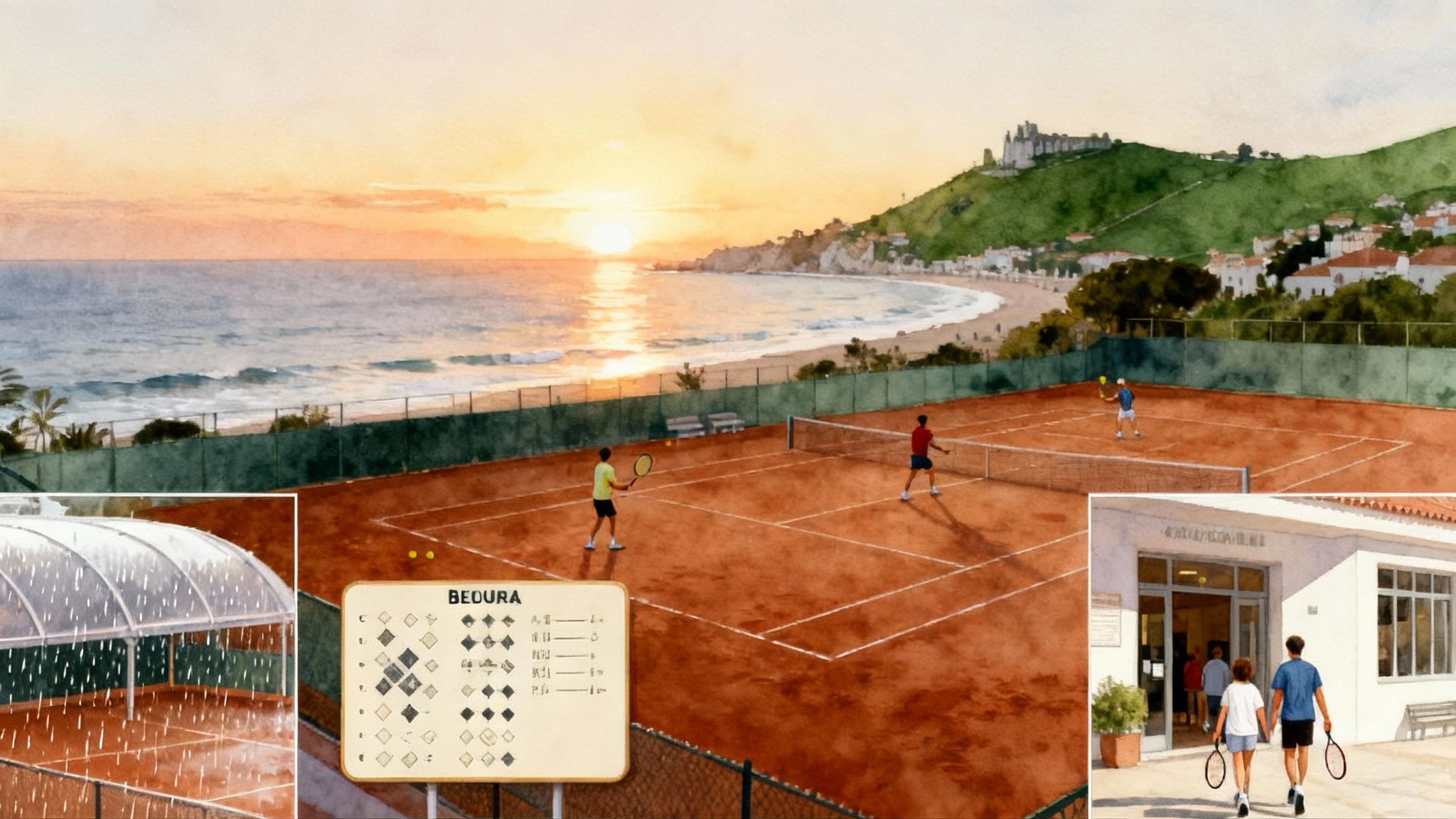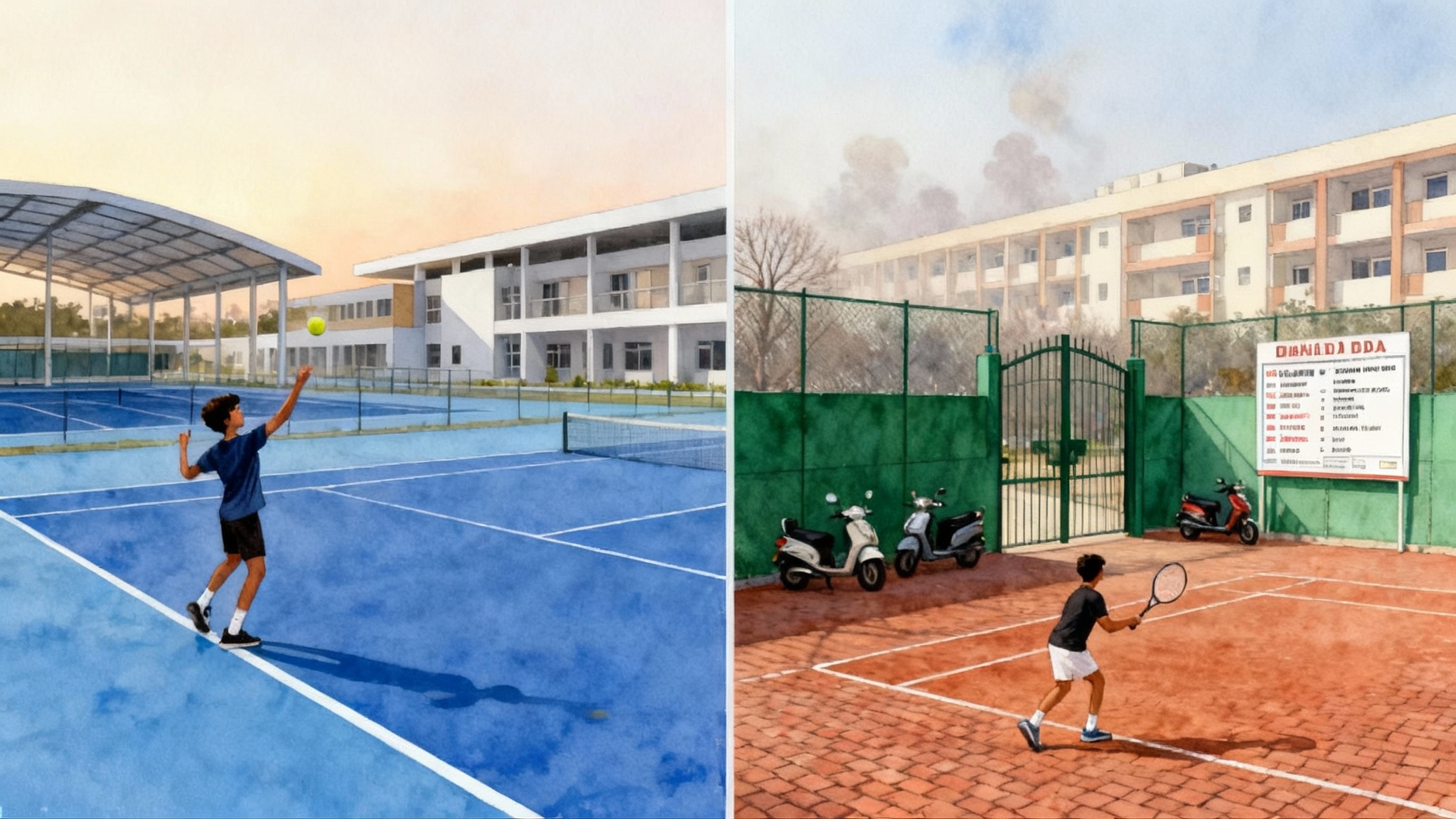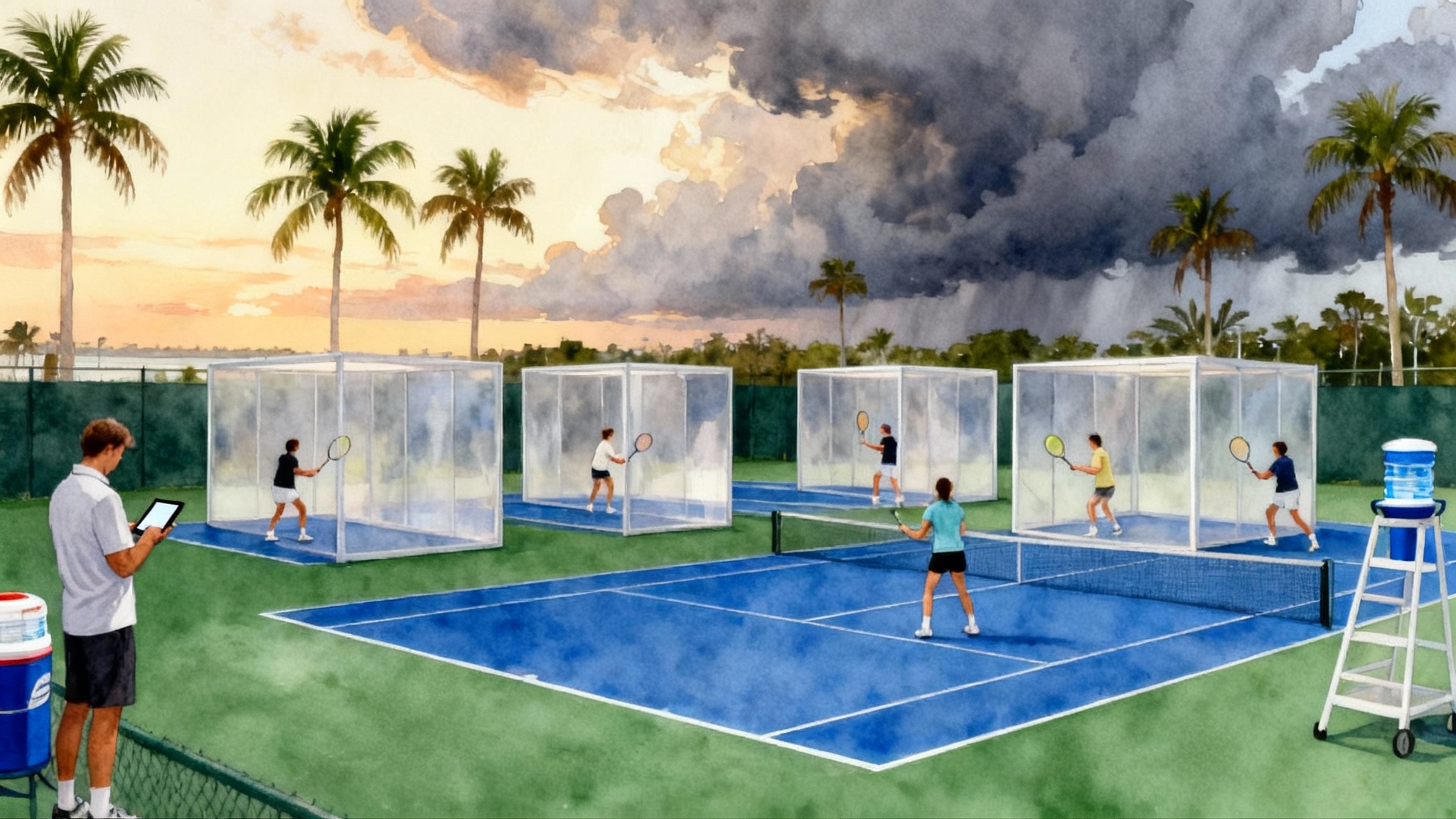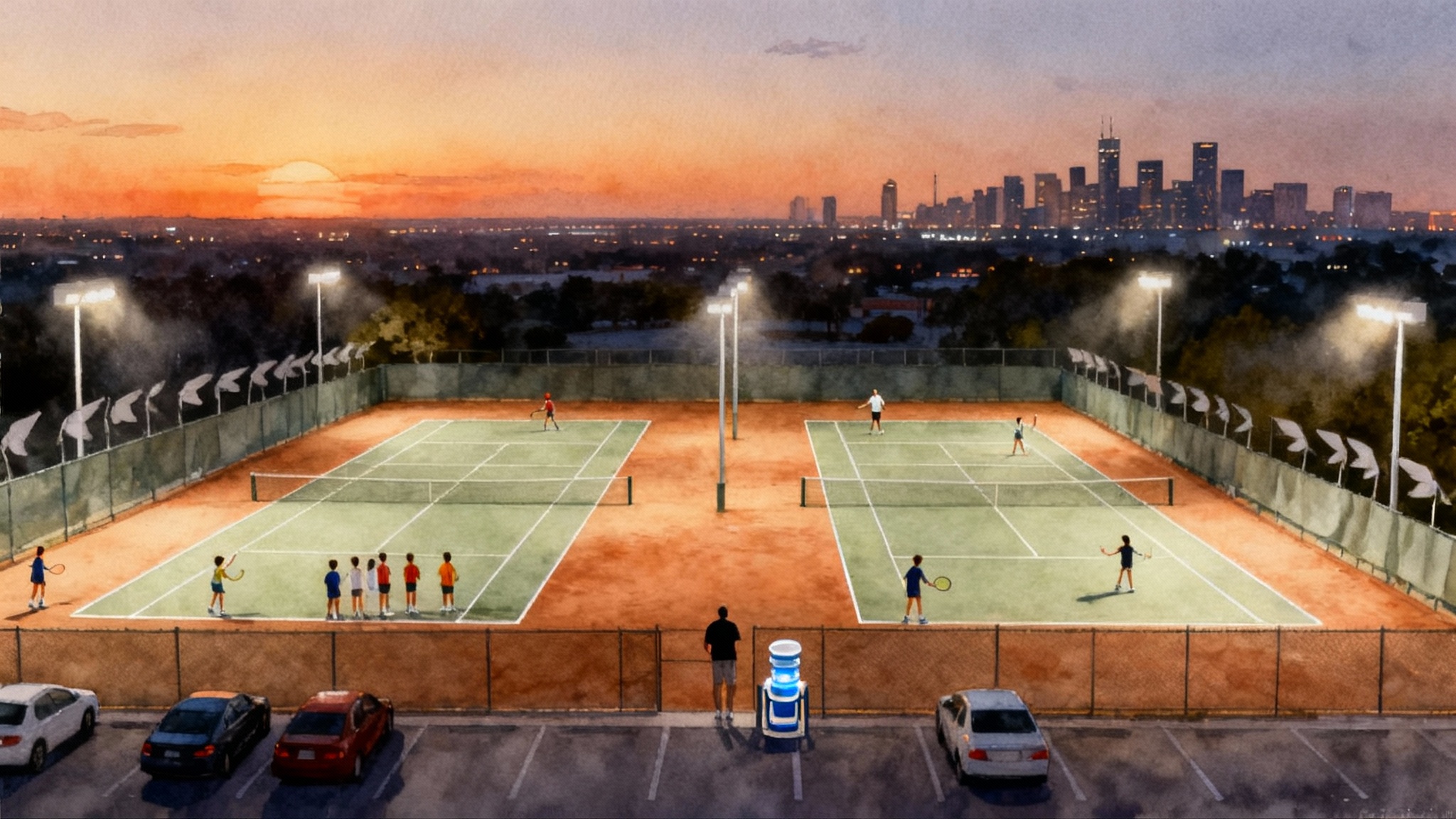Kozerki vs Ghedina: Central Europe Tennis Academies 2025–2026
A head-to-head parent guide for 12–16-year-old competitors comparing Tenis Kozerki in Poland and Ghedina Tennis Academy in Munich. We cover indoor capacity, clay-court volume, boarding, academics, cost tiers, tournament pathways, travel, visas, and sample training weeks.

Why this comparison matters for 12–16 year olds
Between ages 12 and 16, a player’s habits harden. The right academy is an operating system for growth: surface exposure, winter volume, tournament access, school fit, and family logistics. In Central Europe, two strong but very different options stand out: Tenis Kozerki academy profile in Grodzisk Mazowiecki, Poland, and Ghedina Tennis Academy profile in Munich, Germany. One is a purpose-built campus with on-site events and boarding. The other embeds your player inside a classic German club, modeling the team-and-league pathway that built generations of competitors.
This guide is written for international parents, especially from the United States, planning a 2025–2026 training year.
The two models at a glance
Tenis Kozerki in one minute
- Environment: a modern multi-sport campus near Warsaw with hard and clay courts, a performance gym, recovery spaces, pools, and an on-site hotel. Winter tennis is protected by indoor hard courts, so volume stays high when temperatures drop.
- Tournament ecosystem: the venue hosts an ATP Challenger week in August, a practical showcase and motivation point for juniors who can train while professionals compete on nearby courts.
- Schooling: Kozerki communicates a secondary school on campus and organizes study support around training blocks, which reduces travel time between school and practice.
- Boarding: on-site hotel and residence options make this a true campus model.
Ghedina Tennis Academy in Munich in one minute
- Environment: a coaching program based at TC Grün-Gold in the Giesing district. Summer training runs on six outdoor clay courts. Winter training shifts under a two-court air dome on clay, which means year-round touch on red dirt.
- Tournament ecosystem: the German pathway emphasizes league tennis and Deutscher Tennis Bund tournaments. Players learn to compete weekly with club teams and then step into national ranking events.
- Schooling: there is no in-house school. Families integrate academics through local public or international schools, or accredited online providers. The club-integrated model is flexible but requires more family coordination.
- Housing: not a boarding campus. Families arrange apartments or host-family options within Munich’s neighborhoods.
Think of Kozerki as a self-contained training village and Ghedina as a strong program plugged into Munich’s deep club culture. Both produce serious habits. The daily rhythm is different.
Winter indoor capacity, the calendar’s stress test
Winter is where good intentions go to die or thrive. When snow hits, capacity and scheduling decide whether your player keeps repetition high.
- Kozerki: winter volume is anchored by indoor hard courts on site. Training blocks continue on a consistent schedule, with minimal commuting and low weather risk. For a player who builds weapons off serve and first strike, the indoor hard environment is a gift. The predictable bounce simplifies technical changes and makes it easier to collect high-quality repetitions.
- Munich with Ghedina: the winter bubble at TC Grün-Gold offers two indoor clay courts, so slots must be planned and shared. The upside is continuity on clay through the off-season. If your player’s identity leans on point construction, defense-to-offense patterns, and heavy spin, winter clay keeps those skills sharp. Families should expect more calendar choreography to secure court time at peak hours.
Bottom line: choose Kozerki to maximize frictionless winter volume on fast courts. Choose Ghedina if winter clay is nonnegotiable and your player thrives on longer points.
Clay-court volume and surface translation
- Kozerki: a mixed-surface setting. Outdoor clay is available in season, complemented by a large supply of hard. This blend teaches juniors to translate patterns between surfaces. Coaches can run a block on clay for footwork and resilience, then confirm new patterns on hard to accelerate ball speed.
- Ghedina at TC Grün-Gold: clay is the default. Six outdoor clay courts in summer and a clay bubble in winter create year-round red-dirt identity. Expect a strong emphasis on movement economy, building depth to forehand corners, and the discipline of point construction.
If your player aims for North American hard events, Kozerki leans into that identity while still giving clay reps. If long-term goals include European spring swings or Tennis Europe circuits, Munich’s clay-first environment can be ideal.
Boarding vs. club-integrated life
- Kozerki: boarding means fewer moving parts. Sleep, eat, school, train, recover, repeat. For families overseas, a campus removes the challenge of piecing together housing, travel, and school drop-offs. The tradeoff is less exposure to city life and the need to be comfortable with a residential setup.
- Ghedina in Munich: the club-integrated model means your player trains where local teams play, eats nearby, and goes to school across town. It mirrors the life of a German junior. Independence grows faster, but so does the workload on the parent project manager who coordinates housing, metro passes, and academic schedules.
Academics integration
- Kozerki: the academy supports schoolwork on campus, with access to a secondary school and structured study times. For international families, ask for sample timetables, the language of instruction, and how the school interfaces with your home curriculum or college-bound plan.
- Munich: choose among public Gymnasium tracks, bilingual programs, international schools that offer IB or AP courses, or a hybrid with an accredited online provider. The key is a written weekly study plan that syncs with the club’s court blocks and strength sessions. Ghedina coaches can collaborate on cadence, but parents should drive the academic architecture.
Cost tiers, in plain language
Prices change every season, and line items vary by player. Rather than publish numbers that will age quickly, use these tiers to budget and to ask each academy for a written, all-in quote.
- Budget tier: court fees in off-peak windows, two to four squad sessions weekly, one to two private lessons, limited strength training, self-catered meals, and apartment share or host family. Airfare, insurance, and tournament travel are extra.
- Mid tier: five to eight on-court sessions weekly, regular private lessons, structured strength and movement twice weekly, supervised study blocks, nutrition support, and either on-site boarding with shared rooms or a compact apartment near the club.
- Premium tier: daily court access, dedicated private coaching blocks, integrated physiotherapy, sport psychology sessions, match video analysis, full meal plan, and single or twin boarding with transport covered for tournaments.
Request that each academy quote the same basket of items so you can compare apples to apples: on-court hours, private lesson minutes, gym sessions, physio access, video analysis, tournament coaching per day, boarding type, meal plan, laundry, airport transfers, and study supervision.
Tournament pathways: Challenger ecosystem vs. German league and DTB
- Kozerki pathway: the campus hosts a professional week every August. Juniors can see the speed of the modern game up close, feel the routines of pros, and sometimes spar with traveling players or college-bound alumni in the lead-up. For families planning August in Poland, use the official ATP page for dates and draws: Grodzisk Mazowiecki Kozerki Open.
- Munich pathway: Germany’s club leagues and Deutscher Tennis Bund ranking tournaments are an engine for steady competition. Players earn national ranking points through DTB events and spend spring and summer anchoring weekends with team matches. To understand ranking and event listings, start with the DTB’s overview: DTB ranking and tournament calendar.
Practical difference: Kozerki concentrates a spike of pro-level stimulus on-site and surrounds you with regional ITF entries. Munich gives you a marathon of league matches and a deep calendar of DTB events across Bavaria and beyond. Choose the rhythm that complements your player’s personality and school shape.
Logistics for international families
- Visas and entry rules: U.S. citizens can typically enter Poland or Germany visa-free for short stays up to 90 days within any 180-day period. The European Union is rolling out new border systems, including biometric entry records and a separate ETIAS travel authorization. Check current official guidance before booking, and ask the academy which national visa category they support for minors who stay longer than 90 days.
- Airports and transfers: for Kozerki, fly into Warsaw Chopin, then a 45–60 minute drive to campus depending on traffic. For Munich, fly into Munich International, then 20–35 minutes to TC Grün-Gold in Giesing. Ask both academies about arranged airport pickups for unaccompanied minors.
- Language: English is widely used in both environments. Day-to-day in Poland favors Polish outside city centers. Munich is easy in English near the academy and in international programs. A weekly language lesson pays back quickly in both locations.
- Health and insurance: confirm that your player has travel medical coverage valid in the European Union, plus coverage for physiotherapy. Ask how injuries are triaged and whether the academy accompanies minors to clinics.
- Guardianship: if a parent is not staying full-time, arrange a notarized guardianship letter naming a local adult and listing medical consent, school consent, and travel consent. Both academies can advise on local practice.
Decision matrix by player profile
Use these profiles to stress-test your choice.
- Power server moving to first-strike tennis, age 14–16
- Choose Kozerki if you want heavy indoor hard volume from November to March, daily serve plus plus-one drilling, and pro-week exposure in August.
- Choose Ghedina if you want weapons that also win on clay and you are willing to manage tighter winter court supply.
- Counterpuncher building point construction and patience, age 12–15
- Choose Ghedina for clay immersion all year and frequent league matches that teach scoreboard resilience.
- Choose Kozerki for a balanced diet: clay blocks to build patterns, hard blocks to speed them up.
- Academics-first with top-50 national junior goals, age 12–14
- Choose Kozerki for campus consolidation if you need protected study windows and minimal commuting.
- Choose Ghedina if you have a stable school plan in Munich and value the cultural independence of city living.
- International tournament hunter chasing Tennis Europe and ITF juniors
- Choose Kozerki if you want late-summer ITF clustering around Warsaw and the motivational spike of an on-site Challenger.
- Choose Ghedina if you want a long runway of DTB events, then hop to neighboring countries on weekends.
For more head-to-head context on how to compare very different ecosystems, see our Rafa Nadal Kuwait vs Aspire Qatar guide.
Sample weekly plans you can copy
These are realistic frameworks. Swap days to match coaching availability and school obligations.
Winter training block, Kozerki campus
- Monday: am warm-up, technical session on indoor hard with serve plus forehand depth. pm strength block focused on lower body force and trunk rotation. Evening study hall.
- Tuesday: am patterns on hard, cross-court forehand to backhand plus plus-one. pm mobility and prehab. Thirty minutes of video review.
- Wednesday: am point construction on clay if weather allows or simulated on hard with targets. pm match set play with chaperoned scoring. Short journaling on patterns won and lost.
- Thursday: am serve variety plus return depth. pm sprint mechanics and deceleration drills. Light recovery swim.
- Friday: am match play on indoor hard. pm coach debrief and individual homework for weekend.
- Saturday: tournament entry or internal ladder matches. Evening movie or team social on campus.
- Sunday: recovery, study, optional light hit or walk.
Winter training block, Munich with Ghedina
- Monday: am movement on clay bubble, first step and slide timing. pm strength circuit emphasizing single-leg control and calf resilience.
- Tuesday: am cross-court forehand heaviness and depth, finishing patterns with the inside-out forehand. pm German language class or school prep. Evening video of points from league matches.
- Wednesday: am return plus rally tolerance on clay. pm mobility and prehab for hips and adductors.
- Thursday: am pattern alternation drills, backhand change line under pressure. pm doubles patterns for upcoming team matches.
- Friday: am match sets in the bubble. pm coach debrief, set weekend DTB tournament plan.
- Saturday: DTB ranking match or club team practice. Evening family dinner and recovery.
- Sunday: tournament day two or light hit and study.
Summer 2026 camp week, Kozerki
- Monday to Saturday: two on-court sessions daily split between hard and clay to teach translation. Daily serve clinic, midweek match-play day, and Friday test sets. Afternoon pool recovery, one session of sport psychology on routines.
- Saturday: camp match day with scoring under supervision. Awards and feedback report.
- Sunday: rest or travel.
Summer 2026 camp week, Munich with Ghedina
- Monday to Saturday: morning clay technical block, afternoon competition block with ladder matches or a local one-day DTB event if scheduled. Midweek club barbecue to meet league captains. End-of-week report sent to parents.
How to run a fair selection in three calls
- Book a trial week. Ask both academies to place your player with their top training group for three days, plus one private assessment and a sparring session with an older junior. Watch how quickly the plan adapts after day one.
- Request a written training load plan. You want a week-by-week layout listing court hours, private minutes, gym minutes, study blocks, and targeted tournaments with dates. If the plan looks like marketing copy, ask for specifics by date and coach name.
- Map the competition year. For Kozerki, anchor around early August and build satellite ITF events within four hours by train. For Munich, anchor around the club league calendar and pre-select DTB ranking events each month. Make sure exam weeks and travel windows are visible.
Verdict
There is no universal best. If your player needs a high-volume, low-friction training village with a motivational pro week on their doorstep, Kozerki fits that bill. If your player learns best inside a league culture with weekly matches and red clay as a teacher, Ghedina’s club-integrated Munich route is hard to beat. Both can work beautifully. The winning choice is the one that your family can sustain for nine to twelve months with consistent sleep, study, and match play. Pick the rhythm your player will actually live, then commit to it.








